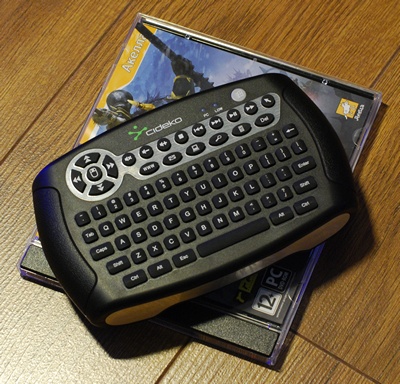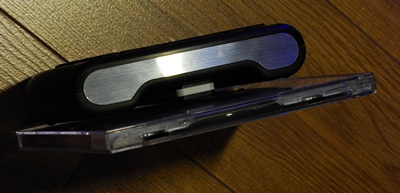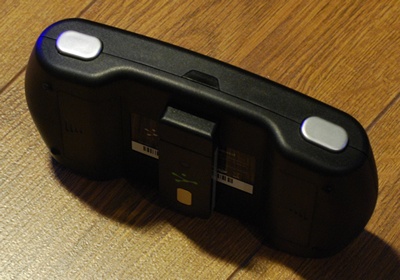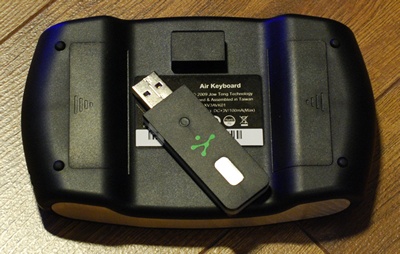Cideko Air Keyboard Review
 Many, like me, are now using nettops (or ultra-compact PCs) to build home multimedia centers. It is convenient and not much more expensive than using ready-made players, although it requires enough time to debug the entire system as a whole. (The main reason why I chose the nettop was the opportunity to watch Turbofilm's favorite, which players as far as I know know, no.)
Many, like me, are now using nettops (or ultra-compact PCs) to build home multimedia centers. It is convenient and not much more expensive than using ready-made players, although it requires enough time to debug the entire system as a whole. (The main reason why I chose the nettop was the opportunity to watch Turbofilm's favorite, which players as far as I know know, no.)Naturally, the main way to watch a video on such a kit (TV + computer) is lying on a sofa / bed or sitting in a chair, which requires a non-standard computer management kit, since familiar keyboard and mouse, even wireless, conveniently positioned nowhere. The simplest solution is to purchase an IR remote control, which is now quite a lot, but they are all limited in functionality, for example, typing the URL in the address bar of the browser will be problematic. In this regard, I decided to look for a wireless keyboard with an integrated ability to control the mouse.
In Moscow, in fact, there were not so many options that suit me in terms of functionality, this is dinite mini from Logitech, but the model is already quite old, and it is still quite expensive (on the market from 2500 now, at the time of the search there were from 5000) , plus the touchpad did not really deceive me. There are also full-size keyboards with trackpoints and trackballs, but this option is very cumbersome, plus prices, even for Genius, are quite high. Another on the Internet came across a description of a mini keyboard from Lenovo, a T-shaped, but I did not really like it. As a result, I decided to order the Cideko Air Keyboard , which I had desired earlier, which was written on Habré in February.
')
* photos are clickable
Order
Because Amazon, on which the keyboard appeared quite a long time, only carries books to Russia, I had to look for it on sale myself, at that time [the beginning of June, I’ve been using it for a long time :)], of all eBay sellers (there were 3 of them .. 4) no one wanted to send it to Moscow to me, so only the store options remained. Glory to Google, he helped me find the much-desired device on the site of one of the English stores - Cutebitz . Fortunately, there were no problems with payment and delivery to Russia and the keyboard was sent to me.
Cost of
The keyboard itself - £ 69.95
Delivery - £ 19.95
Total - £ 89.90
Those. In total, it came out much cheaper than dinovo mini in Moscow at that time, well, the device itself was much prettier to me. The package came to me somewhere in two weeks, which was very nice, the keyboard was packed in a box with a transparent plastic insert, and the box itself was in a large envelope. In the process of sending the box was slightly crushed, but the insides were not injured. In the box is the keyboard itself, the transmitter, instructions and batteries.
Appearance
 The keyboard itself is small, placed on the palm of your hand, made of high-quality matte plastic, “cheeks” have a texture under the skin, anti-slip. Build quality is excellent, nothing creaks and does not play. With batteries it has a pleasant weight, about 200 grams. The keys from either very hard rubber or relatively soft plastic are not very clear, but tactile to press them is pleasant, the stroke is small, but with a clear click, inside, apparently microswitches, there is no mechanism like in full-size keyboards. I think the keys are made on one sheet of this material and there are switches on the board below them. The inscriptions are painted, for two months of use, not too active, of course, no signs of erasing the inscriptions have appeared. Below and on the front there are stickers made of plastic for metal, decorative in nature. In the lower right corner of the keyboard there are holes for attaching the lace. Below there are 4 rubber-coated anti-slip legs, two battery compartment covers (the keyboard is powered by two AA batteries symmetrically located in the thickenings of the case) and the latch for mounting the transmitter when it is not in use. The transmitter itself is also made of matte plastic with a single key and a diode, the key serves to “pair” the transmitter and keyboard, the diode is lit synchronously with the data transfer diode on the keyboard (will be described later), similar to a USB flash drive.
The keyboard itself is small, placed on the palm of your hand, made of high-quality matte plastic, “cheeks” have a texture under the skin, anti-slip. Build quality is excellent, nothing creaks and does not play. With batteries it has a pleasant weight, about 200 grams. The keys from either very hard rubber or relatively soft plastic are not very clear, but tactile to press them is pleasant, the stroke is small, but with a clear click, inside, apparently microswitches, there is no mechanism like in full-size keyboards. I think the keys are made on one sheet of this material and there are switches on the board below them. The inscriptions are painted, for two months of use, not too active, of course, no signs of erasing the inscriptions have appeared. Below and on the front there are stickers made of plastic for metal, decorative in nature. In the lower right corner of the keyboard there are holes for attaching the lace. Below there are 4 rubber-coated anti-slip legs, two battery compartment covers (the keyboard is powered by two AA batteries symmetrically located in the thickenings of the case) and the latch for mounting the transmitter when it is not in use. The transmitter itself is also made of matte plastic with a single key and a diode, the key serves to “pair” the transmitter and keyboard, the diode is lit synchronously with the data transfer diode on the keyboard (will be described later), similar to a USB flash drive.
Keys
In the presence of a complete qwerty layout, as well as a set of additional functional and multimedia keys. At first glance it may seem that in the upper left corner of the mouse control key, but in fact it is the cursor keys - “arrows”, and in the center there is an emulation button for pressing the middle mouse button. The “mouse” keys themselves - left and right - are located on the upper end. The same cursor is controlled by tilting the keyboard itself, more on that later. There are buttons for controlling the volume (mute / - / +) and playback of multimedia files (stop / back / forward / play / fastforward). To the right of them, with the cursor, the button for disabling the mouse control. Above these keys is a gray Start menu call button and operation indicators: PC, lit when the keyboard is on, blinks when the keyboard changes its position in space (mouse control) and the keys are pressed, and LOW should blink when the batteries are low (not yet seen). There are also several shortcuts for quick access to applications - browser, email program, My computer, search and calculator. To the right - Delete. It should also be noted that there are no F * keys, which is not very important (although using Alt + F4 would be convenient), but nevertheless, and also that Esc does exist, in an unusual place - to the left of the space.
In general, the buttons are very comfortable and ergonomic, due to the fact that the location is standard, and the keys are clearly separated and convex, you can easily press them blindly. Perhaps, there are not enough tags on F and J. Well, the Russian layout, which is obvious, it can be applied, but, most likely, only between the keys, or to make stickers. So far I have not done this.


Mouse
The main "feature" of the keyboard is mouse control with accelerometers (at the time the keyboard came out and purchased it - the beginning of the year - it was a unique functionality, now there are remote controls with similar functionality). The up-and-down cursor moves by tilting the keyboard away from you and towards yourself, left-right by turning the keyboard in the appropriate direction, like a steering wheel, which is not very intuitive at first - you want to tilt it left-right (you can watch the video here not mine). Why this is done to me is not very clear, but you quickly get used to it and it becomes quite comfortable, even controlling one hand :). Delays in data transfer are minimal, and positioning accuracy is high, after a small workout, all links and buttons are pressed the first time, as well as dragging objects, etc. In this regard, absolutely nothing to complain about. I didn’t try it in games, but I think that if I adapt myself, then it will be possible to play strategy completely, at the expense of shooters - I don’t know :)

Transmitter, work
The transmitter is plugged into the USB, with a diode blinking during operation. The diode is bright, so it’s better not to direct the eyes, for me it looks at the wall, because there is no benefit from watching him =) As I understand it, it fully emulates the usb keyboard and mouse stuck into the usb hub, i.e. No drivers are needed for work, the operating system does not matter (except, perhaps, the additional key). Also, the keyboard works without problems in the BIOS. I think admins would be useful, except for the lack of F * series. The keyboard's response, as I already wrote, is practically, like a wired one, the mouse lag is present, but does not interfere at all.
The method of data transmission is not described, apparently something proprietary with connection support during operation, the frequency varies between 863 ~ 870MHz / 902 ~ 968MHz / 2400MHz ~ 2483MHz, the working range is selected automatically, depending on the current frequency, from 10 to 30 meters. The manufacturer promises about 50 hours of work from one set of batteries, taking into account the specifics of use, I think that will be enough for a very long time. Moreover, the energy saving system is well thought out: after 10 seconds of inactivity (no clicks, the keyboard is motionless), the power saving mode turns on, I think the connection with the computer is broken to wake it up, just press any key or just move it. After 4 minutes of idle time, the keyboard turns off completely, so you need to click the “left mouse button” to turn it on.
Conclusion
I am very pleased with the purchase and will order the second one if I collect the same system again. Judging by the news on the Internet, MSI wants to sell the keyboard under its brand, which means it can be sold in Russia and localization, respectively.
Great product.
Photos by mi55er
Source: https://habr.com/ru/post/101880/
All Articles